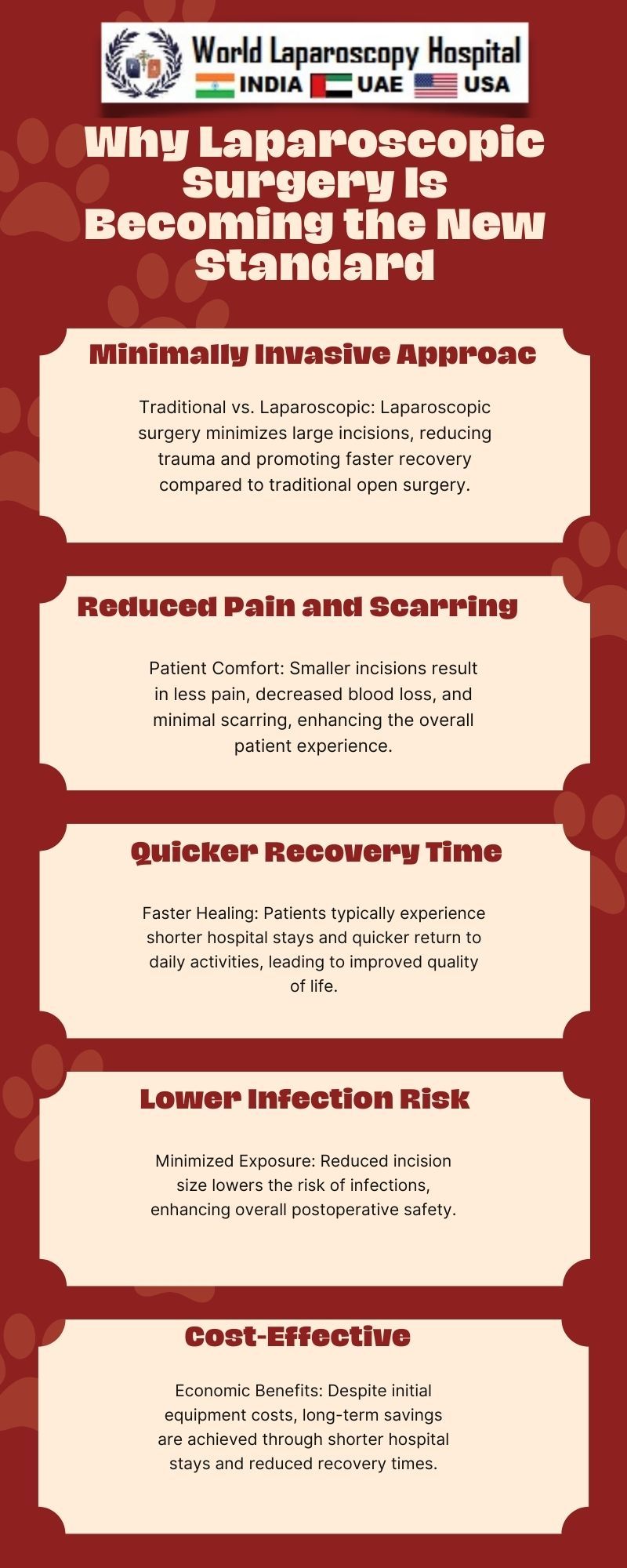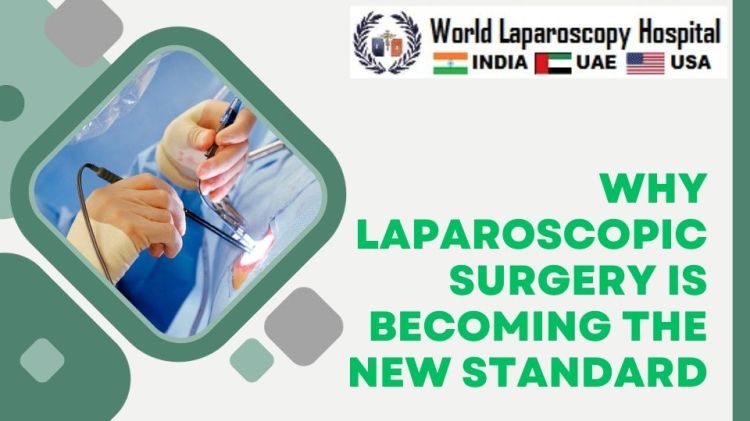Why Laparoscopic Surgery Is Becoming the New Standard
Introduction:
In the ever-evolving landscape of medical advancements, one groundbreaking innovation has reshaped the field of surgery—laparoscopic surgery. Once considered a novel approach, it has now emerged as the new standard in many surgical procedures. This minimally invasive technique has revolutionized the way surgeons operate, offering a myriad of benefits to both patients and medical professionals alike. In this comprehensive exploration, we will delve into the reasons behind the widespread adoption of laparoscopic surgery and how it has become the preferred choice across various medical specialties.

The Genesis of Laparoscopic Surgery:
Historical Perspective:
To comprehend the significance of laparoscopic surgery's rise, it is crucial to trace its origins. The roots of this technique can be traced back to the early 20th century, with intermittent milestones leading to its eventual widespread acceptance. Initially used for diagnostic purposes, laparoscopy gradually evolved into a therapeutic tool.
Technological Advancements:
The technological evolution in the medical field played a pivotal role in the development of laparoscopic surgery. The introduction of fiber optics and miniature cameras in the mid-20th century laid the groundwork for the visualization aspects of this technique. The subsequent integration of advanced tools and robotic assistance further propelled laparoscopic surgery into the mainstream.
Understanding Laparoscopic Surgery:
The Procedure:
Laparoscopic surgery involves making small incisions through which a laparoscope—a thin tube with a light and camera—is inserted. This allows surgeons to visualize the internal organs on a monitor. Specialized instruments are then used to perform the surgery through additional small incisions. Compared to traditional open surgery, which requires a large incision, laparoscopic procedures are characterized by their minimally invasive nature.
Versatility Across Specialties:
One of the key reasons behind the surge in laparoscopic surgery's popularity is its versatility. Initially applied in gynecology and general surgery, it has expanded its reach to various medical specialties, including urology, orthopedics, and even certain cardiac procedures. The adaptability of laparoscopic techniques showcases its transformative impact on diverse branches of medicine.
Advantages of Laparoscopic Surgery:
Reduced Recovery Time:
One of the foremost benefits of laparoscopic surgery is the significantly reduced recovery time compared to traditional open procedures. Smaller incisions result in less trauma to the body, allowing patients to resume their daily activities sooner. This has profound implications for both the individual's quality of life and the overall efficiency of healthcare systems.
Minimal Scarring:
The aesthetic aspect cannot be overlooked, as laparoscopic surgery leaves minimal scarring. This is particularly significant for patients who value cosmetic outcomes and wish to avoid the long, visible scars associated with open surgery. The psychological impact of reduced scarring can contribute to improved patient satisfaction and postoperative well-being.
Lower Infection Rates:
The risk of postoperative infections is inherently lower with laparoscopic surgery. Smaller incisions translate to a decreased likelihood of wound complications, minimizing the chances of infections that can prolong recovery and necessitate additional medical intervention.
Less Pain and Discomfort:
Patients undergoing laparoscopic procedures commonly report less postoperative pain and discomfort compared to their counterparts undergoing open surgery. This is attributed to the smaller incisions and reduced tissue trauma, fostering a more comfortable recovery experience.
Precision and Enhanced Visualization:
High-Definition Imaging:
Laparoscopic surgery provides surgeons with high-definition, magnified images of the surgical site. This level of detail allows for enhanced visualization, enabling precise manipulation of tissues and organs. The improved clarity contributes to the accuracy of the procedure, reducing the likelihood of errors and complications.
Improved Instrument Maneuverability:
The design of laparoscopic instruments allows for intricate maneuvers within the confined spaces of the body. The articulation of these instruments replicates the dexterity of the human hand, facilitating intricate tasks with greater precision. Surgeons can navigate challenging anatomical structures with finesse, expanding the scope of what can be accomplished through minimally invasive means.
Economic Considerations and Healthcare Efficiency:
Cost-effectiveness:
While the initial setup for laparoscopic surgery may involve higher costs due to specialized equipment, the overall economic impact tends to be favorable. Reduced hospital stays, faster recovery times, and diminished postoperative complications contribute to cost savings for both patients and healthcare systems in the long run.
Increased Surgical Throughput:
Laparoscopic surgery's efficiency extends beyond individual patient outcomes; it positively influences surgical throughput. The minimally invasive nature of the procedure allows for quicker turnover in operating rooms, enabling surgeons to perform a higher volume of surgeries within a given time frame. This increased efficiency addresses the growing demands on healthcare resources.
Evolution in Training and Surgeon Competence:
Specialized Training Programs:
The widespread adoption of laparoscopic surgery has prompted a paradigm shift in surgical training. As this technique requires a unique skill set, specialized training programs and simulation tools have been developed to ensure surgeons acquire the proficiency needed for successful laparoscopic procedures. This evolution in training contributes to the continued growth of laparoscopic surgery across medical disciplines.
Surgeon Adaptability:
The adaptability of surgeons to evolving techniques is a crucial factor in the integration of laparoscopic surgery as the new standard. The willingness of medical professionals to embrace and master minimally invasive procedures reflects a commitment to enhancing patient care through innovative approaches.
Challenges and Future Directions:
Learning Curve:
Despite its numerous advantages, laparoscopic surgery presents a learning curve for surgeons transitioning from traditional open techniques. The acquisition of proficiency in laparoscopic skills demands time and dedicated training, with some surgeons facing challenges in adapting to the nuances of minimally invasive procedures.
Ongoing Technological Innovations:
The field of laparoscopic surgery continues to evolve with ongoing technological innovations. Robotics, augmented reality, and artificial intelligence are being integrated to further enhance the capabilities of minimally invasive procedures. These advancements hold the potential to address current challenges and expand the scope of laparoscopic surgery even further.
Patient Selection Criteria:
Optimal patient selection remains a crucial consideration in maximizing the benefits of laparoscopic surgery. While many patients are suitable candidates for minimally invasive procedures, certain cases may still require traditional open surgery. The development of refined patient selection criteria will contribute to better outcomes and patient satisfaction.
Conclusion:
Laparoscopic surgery's ascent to becoming the new standard in various medical specialties is a testament to its transformative impact on patient care and surgical practices. The amalgamation of technological advancements, economic considerations, and improved surgical outcomes has positioned laparoscopic surgery as a cornerstone of modern healthcare. As we continue to witness innovations in surgical techniques and technologies, the legacy of laparoscopic surgery is likely to endure, shaping the future landscape of surgical interventions.
